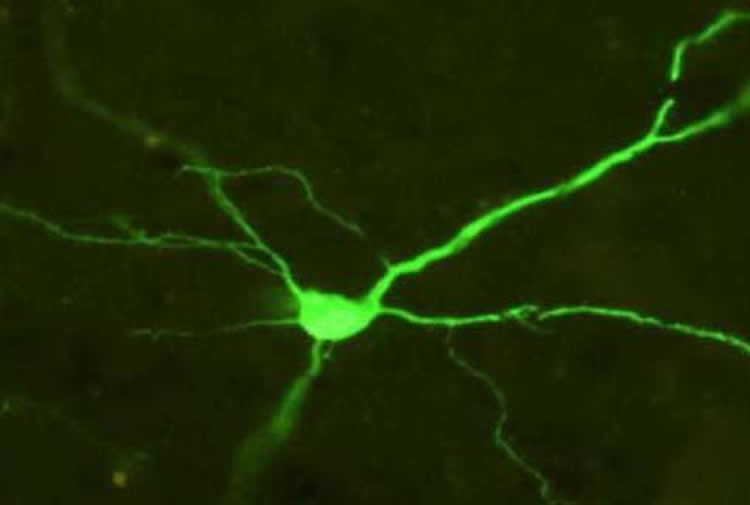Summary: Researchers uncover a casual relationship between behavioral control and a specific imbalance in brain function that exists during adolescence.
Source: Dartmouth College.
Findings demonstrate a causal link between imbalanced brain activity and behavioral control.
Adolescents among humans and non-human animals alike are more inclined to engage in heightened risk-taking behavior, exploration and novelty seeking. Although these attributes provide adaptive value in enabling individuals to gain importance in the world, including independence from parents, if taken too far, this tendency could lead to potentially dangerous behavior, including drug use, harmful drinking, addiction, unsafe sex, and risky driving, which may result in unintended injuries, violence and/or even premature death. A new Dartmouth study just published in Current Biology demonstrates for the first time, the causal relationship between behavioral control and a specific imbalance in brain function that exists during adolescence.
Adolescent-specific behavior may be driven by an imbalance in activity between the prefrontal cortex (PFC), an area of the brain involved in cognitive control and inhibition, which does not fully develop until the late teens/early 20s, and the nucleus accumbens (NAC), which plays a central role in reward-seeking and addiction. Past research has found that adolescents that engage in risk-taking behavior have trouble inhibiting such behavior as compared to either adults or pre-adolescents. Researchers have postulated that the low activity in PFC with concurrent high activity in NAC, an imbalance which appears to exist only during adolescence, is essentially at odds with each other.
To test the causal imbalance, Heidi C. Meyer, a graduate student working in Professor David J. Bucci’s Neurobiology of Learning and Memory Laboratory at Dartmouth, used a chemogenetic approach, known as Designer Receptors Exclusively Activated by Designer Drugs (DREADDs), to simulate the imbalance that takes place during adolescence by simultaneously altering the activity in PFC and NAC. DREADDs enables researchers to “remotely control” the activity of brain cells by temporarily turning cells off or on in a region for a short period of time, by injecting a virus that transfers genes for a synthetic receptor, which is only responsive to a synthetic drug that is also administered through a simple injection, which turns brain cells off or on temporarily.

For the study, researchers used adult rats, which normally have balanced activity in these areas and used the DREADD approach to decrease the activity in PFC and simultaneously increase activity in NAC while the rats learned an inhibition task. A tone presented by itself signaled to the rats that a food reward would be delivered; however, a light preceding the tone indicated that there would be no food reward. Past studies on inhibition have typically examined reactive inhibition or the ability to stop a response once it has been initiated; yet, Dartmouth’s study tested proactive inhibition or the ability to withhold an inappropriate response in the first place. The rats that were treated with the DREADD approach exhibited a dramatic delay in learning to inhibit their response to the tone when it was preceded by the light, requiring twice the amount of training to learn the behavior. The delay in learning this inhibitory response matched the delay that the researchers observed in normal adolescent rats during an earlier study. The new findings also illustrate how this form of proactive inhibition is age-dependent, which is consistent with the researchers’ previous work on how inhibition is impaired during adolescence.
“Understanding how specific changes in brain function during development relate to behavior is critically important for determining why some individuals engage in excessive risk taking behavior during adolescence,” says David J. Bucci, the Ralph and Richard Lazarus Professor of Psychological and Brain Sciences at Dartmouth and senior author of the study. “Our hope is that these findings will inform new means to minimize the potential for engaging in drug use and other harmful behaviors during this important period of development.”
Heidi C. Meyer, a graduate student in Bucci’s lab at the time of the study, also served as a co-author and is now a postdoctoral fellow at Weill Cornell Medical College in New York City.
Source: Amy D. Olson – Dartmouth College
Image Source: NeuroscienceNews.com image is credited to David J. Bucci, Dartmouth College.
Original Research: Abstract for “Imbalanced Activity in the Orbitofrontal Cortex and Nucleus Accumbens Impairs Behavioral Inhibition” by Heidi C. Meyer and David J. Bucci in Current Biology. Published online September 29 2016 doi:10.1016/j.cub.2016.08.034
[cbtabs][cbtab title=”MLA”]Dartmouth College. “Why Risk Taking Behavior Increases During Adolescence.” NeuroscienceNews. NeuroscienceNews, 17 October 2016.
<https://neurosciencenews.com/risk-taking-adolescence-5304/>.[/cbtab][cbtab title=”APA”]Dartmouth College. (2016, October 17). Why Risk Taking Behavior Increases During Adolescence. NeuroscienceNews. Retrieved October 17, 2016 from https://neurosciencenews.com/risk-taking-adolescence-5304/[/cbtab][cbtab title=”Chicago”]Dartmouth College. “Why Risk Taking Behavior Increases During Adolescence.” https://neurosciencenews.com/risk-taking-adolescence-5304/ (accessed October 17, 2016).[/cbtab][/cbtabs]
Abstract
Imbalanced Activity in the Orbitofrontal Cortex and Nucleus Accumbens Impairs Behavioral Inhibition
Highlights
•DREADDs were used to simultaneously alter neural activity in OFC and NAC
•A functional imbalance between OFC and NAC disrupted inhibitory control
•The data causally support current models of behavioral control during adolescence
•The data provide new insight into the neurobiology of negative occasion setting
Summary
Contemporary models of behavioral regulation maintain that balanced activity between cognitive control areas (prefrontal cortex, PFC) and subcortical reward-related regions (nucleus accumbens, NAC) mediates the selection of appropriate behavioral responses, whereas imbalanced activity (PFC < NAC) results in maladaptive behavior. Imbalance can arise from reduced engagement of PFC (via fatigue or stress) or from excessive activity in NA. Additionally, a concept far less researched is that an imbalance can result from simultaneously low PFC activity and high NAC activity. This occurs during adolescence, when the maturation of PFC lags behind that of NAC and NAC is more functionally active compared to adulthood or pre-adolescence. Accordingly, activity is disproportionately higher in NAC than in PFC, which may contribute to impulsivity and risk-taking exhibited by adolescents. Despite having explanatory value, support for this notion has been solely correlational. Here, we causally tested this using chemogenetics to simultaneously decrease neural activity in the orbitofrontal cortex (OFC) and increase activity in NAC in adult rats, mimicking the imbalance during adolescence. We tested the effects on negative occasion setting, an important yet understudied form of inhibitory learning that may be particularly relevant during adolescence. Rats with combined manipulation of OFC and NAC were impaired in learning to use environmental cues to withhold a response, an effect that was greater than that of either manipulation alone. These findings provide direct evidence that simultaneous underactivity in OFC and overactivity in NAC can negatively impact behavioral control and provide insight into the neural systems that underlie inhibitory learning.
“Imbalanced Activity in the Orbitofrontal Cortex and Nucleus Accumbens Impairs Behavioral Inhibition” by Heidi C. Meyer and David J. Bucci in Current Biology. Published online September 29 2016 doi:10.1016/j.cub.2016.08.034






